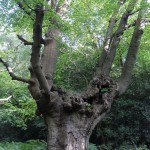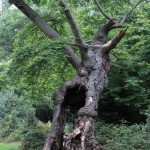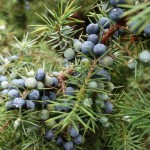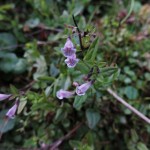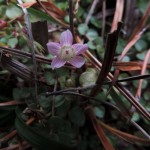Following on from her fascinating talk to the Society in February, Helen Read led a walk at Burnham Beeches on Saturday 5th September. The reserve contains a large number of ancient pollard trees, mostly Beech but also some oaks. Active pollarding ceased about 200 years ago and Helen and her team have had to teach themselves how to look after the ancient trees in order to extend their lives. The walk started out in an enclosure which is being grazed by cattle and Exmoor ponies. An old hollow Beech pollard with aerial roots was inspected. The branches which had grown above the old pollarding point had sent new roots down into the heartwood of the tree. As this decayed and rotted away, the roots were left exposed inside the tree. Further on, Hornets were flying in and out of a hole in an old oak pollard and Common Cow-wheat was in flower beside the path. Nearby, it was surprising to see an acid-loving Rowan and a lime-loving Whitebeam growing close together. Perhaps dry conditions were more important than the acidity of the soil. Another old Beech pollard had been a victim of the previous bank holiday weekend’s wet weather. A big limb had fallen off on one side and then the rest of the tree had split in two and fallen in the opposite direction. Its heartwood was rotten and the sparse foliage on the fallen branches indicated that it had been in poor health. Helen found a big specimen of the Artists’s Palette fungus Ganoderma applanatum on it. A little further on, the ground sloped steeply away below the path and it was possible to look down on two pollards and see how they are being managed. The main branches had been reduced in height and there was plenty of new growth below. Surrounding trees had been cut back or cut down to let in more light. The bare trunk of a neighbouring tree had been left as standing dead wood. The trees are re-cut after 15 – 25 years. As the height is further reduced, the cleared halo is extended and more neighbouring trees need to be cut back to reduce shading. New pollards are also being created for the future. Helen showed the group a young Beech which had recently had its second cut, taking out a few of the biggest branches but leaving a reasonable proportion of the smaller branches.
The walk continued into an open area of wood pasture which closely resembled the New Forest, with scattered trees and clumps of brambles surrounded by lawn-like turf. The next section of the route was an area of heathland where there were a large number of very healthy Juniper bushes. When the area had first been cleared, new plants had been propagated at the Cambridge Botanical Garden, but now the Juniper is regenerating naturally. The route then led down into a wet area, where Marsh and Trailing St John’s-wort and Lesser Skullcap were growing amongst a carpet of Bog Pimpernel and Marsh Pennywort. The final section of the walk was along a boardwalk through a section of mire, where a number of different Sphagnum mosses, rushes and sedges were inspected.
Pictures by Rob Stallard and Laurie Haseler
| RDNHS trip to Burnham Beeches, 05.09.2015; Plant list | ||
| Scientific name | English name | Remarks |
| Woodland plants and trees: | ||
| Fagus sylvatica | Beech | |
| Ilex aquifolium | Holly | |
| Melampyrum pratense | Common Cow-wheat | |
| Pteridium aquilinum | Bracken | |
| Quercus petraea | Sessile Oak | |
| Quercus robur | Pedunculate Oak | |
| Rubus fruticosus | Bramble | |
| Sorbus aria | Common Whitebeam | |
| Sorbus aucuparia | Rowan | |
| Veronica serpyllifolia | Thyme-leaved Speedwell | |
| The Heath: | ||
| Calluna vulgaris | Heather | |
| Carex pilulifera | Pill Sedge | |
| Danthonia decumbens | Heath-grass | |
| Juniperus communis | Juniper | 94 specimens! |
| Poa flexuosa | Wavy Meadow-grass | |
| Potentilla erecta | Tormentil | |
| The Mire: | ||
| Anagallis tenella | Bog Pimpernel | |
| Erica tetralix | Cross-leaved Heath | |
| Hydrocotyle vulgaris | Marsh Pennywort | |
| Hypericum elodes | Marsh St John’s-wort | |
| Scutellaria minor | Lesser Skullcap | |
| Boardwalk: | ||
| Carex binervis | Green-ribbed Sedge | |
| Carex nigra | Common Sedge | |
| Cirsium palustre | Marsh Thistle | |
| Digitalis purpurea | Foxglove | |
| Juncus acutiflorus | Sharp-flowered Rush | |
| Juncus effusus | Soft-rush | |
| Mentha aquatica | Water Mint | |
| Molinia caerulea | Purple Moor-grass | |
| Osmunda regalis | Royal Fern | |
| Persicaria hydropiper | Water Pepper | |
| Polytrichum spec. | ||
| Ranunculus flammula | Lesser Spearwort | |
| Sphagnum palustre | ||
| Ulex europaeus | Gorse | |
List by Renée Grayer

